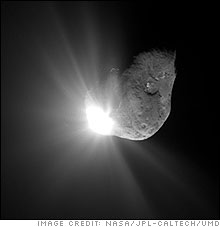A Tenth Planet? Or Just Eight?

In 2003 the dating of an Ethiopian Homo sapiens fossil, “Herto Man,” was hailed as a milestone in paleoanthropology. At 160,000 years old, Herto Man was a full 50,000 years older than any anatomically modern human ever discovered. But now, just two years later, Herto Man has already been replaced as humanity's forefather. And he was dethroned by a couple of skull fossils that have been kicking around, virtually ignored, for the last 40 years.
The skulls, called Omo I and Omo II, were discovered back in 1967 by paleontologist Richard Leakey, near the Omo River in southern Ethiopia. They were thought to be about 130,000 years old, but their dating was not considered definitive. Nor was their age a particularly burning issue at the time—when Leakey discovered the Omo skulls, he had been in hot pursuit of evidence of our earliest, prehuman ancestors, who preceded Homo sapiens by millions of years. As paleontologist John Fleagle of Stony Brook University put it, “The fact of the matter is, they wanted early hominids; modern humans were like chump change.”
In the last several years, however, Fleagle and other researchers determined that the Omo skulls were worth another look. With the help of the latest dating technology, they announced in February that the skulls were an astonishing 195,000 years old, more than 65,000 years older than Herto. After four decades as a side show to Leakey's more spectacular discoveries, the Omo skulls have gone from “chump change” to our most revered elders. Omo is oldest, and Herto is history.
But does age really matter? In this case, it does in fact represent more than just paleontological one-upsmanship. The recalibration of the Omo fossils' ages was not simply undertaken because new technology made it possible, but because pinpointing the age of the earliest humans contributes important evidence to the “Out of Africa” theory—the debate over whether humanity originated in Africa and then migrated to other parts of the world, or whether, according to the subscribers of the multiregionalist theory, Homo sapiens developed independently in various parts of the world. The new dating of Omo, Fleagle contends, “places the first appearance of modern Homo sapiens in Africa many more thousands of years before our species appears on any other continent.” The age of Herto strongly buttressed the “Out of Africa” case two years ago—that's why it was considered such a significant find. Given that the Omo skulls are 65,000 years older, they increase the gap between the emergence of humans in Africa and the much later Homo sapiens fossils found elsewhere in the world.
The Softer Side of T. Rex
 A T. rex skull.
|
In March paleontologists discovered the existence of soft tissue in a 68-million-year-old Tyrannosaurus rex fossil. An unprecedented find in a prehistoric creature—scientists had assumed no such tissue could survive more than 100,000 years—the soft tissue included cells and blood vessels.
The discovery was a serendipitous one. Because this T. rex fossil was located in a remote part of Montana (the Hell Creek formation, where about two dozen species of dinosaurs have been found) the fossil had to be removed by helicopter. According to paleontologist Jack Horner, who participated in the excavation, “we actually had to split the thighbone into two pieces to get it into the helicopter.” When his colleague Mary Schweitzer later examined the hollow cavity of the broken bone in her North Carolina State University lab, she discovered the pliable tissue. Scientists predict the soft tissue will provide a gold mine of information about the physiology of dinosaurs.
Examination of the soft tissue has already yielded several exciting revelations. The tissue included medullary bone, a calcium-enriched substance temporarily present when birds are ready to produce eggshells and lay eggs. Not only does the presence of medullary bone reveal that this particular T. rex was female (paleontologists have never before determined the sex of a dinosaur), but the existence of medullary tissue also supports the widely held theory that modern birds descended from dinosaurs. According to Schweitzer, it “links the reproductive physiology of dinosaurs to birds very closely. It indicates that dinosaurs produced and shelled their eggs much more like modern birds than like modern crocodiles.” Horner commented that “this is another piece to the puzzle and there are a lot of them. Anyone who would argue that birds and dinosaurs are not related—frankly, I'd put them in the Flat Earth Society group. ”
Mind over Matter
In 2001 Matt Nagle, a 25-year-old former football star from Weymouth, Mass., was stabbed in an unprovoked fight that severed his spinal cord. Paralyzed from the neck down, he lost even the ability to breathe on his own. But over the last year, this quadriplegic has performed a seemingly supernatural feat: he can control machines through his thoughts. Thanks to a chip implanted in his brain, Nagle has the ability to convey simple, motor-related thoughts to a computer, which then carries out his actions. He can now change channels on his TV, turn lights on and off, and play computer games simply by thinking about doing these things. In early 2005 he became the first human to reach and grasp objects using an artificial hand by thinking about moving his own paralyzed hand.
In June 2004 surgeons implanted a sensor called the Braingate Neural Interface System in the part of Nagle's brain that controls motor activity. Braingate channels the electrical signals from the brain that normally move through the spinal cord—which in Nagle's case is irreparably damaged—and sends them to wires attached to his skull. The wires convey the brain signals to a computer, which then interprets them and carries out the task.
Nagle is one of the pioneers in the exploding field of neuro-cybernetics, the science of using machines to carry out commands of the human brain. But he was not the first to turn his thoughts into action. Since 1996, a number of paralyzed patients have learned to move a computer cursor and even type messages—albeit laboriously—just by thinking about doing so. In the mid-1990s only a handful of labs were devoted to developing brain-machine interface (BMI) technology; today there are more then 60 labs throughout the world. Some are exploring systems that detect brain waves from outside the body; others, like Braingate, work with brain implants. Some of the most promising experiments have benefitted patients with “locked-in” syndrome—their brain functions normally but they've been robbed of all muscle control. BMI technology has allowed them to use their thoughts to regain rudimentary communication with the outside world.
The lead scientist on the Braingate experiment, John Donoghue of Brown University, believes that Nagle—and eventually other paralyzed people—will eventually regain some control over their environments through BMI technology. Ultimately, Donoghue hopes they'll regain control over their paralyzed limbs. “The technology required is very complex. There are still many issues to be resolved. But it's here. It's going to happen. Just look at Matt.” This year four more volunteers will be added to the Braingate study, and researchers eventually hope to make the implant wireless. At the moment, Nagle can only use the BMI equipment a few times a week because it requires the help of technicians.
The researchers were fortunate to have selected the enormously resolute and optimistic Nagle as their first volunteer. Nagle had to spend months practicing intensively before the computers responded properly to his brain waves. And not only was there the real possibility that he might spend fruitless years involved in a failed experiment, but the brain implant also involved the risk of physical damage and psychiatric problems. “My mother was scared of what might happen, but what else can they do to me?” Nagle commented. “I was in a corner, and I had to come out fighting.”
Earthlings Attack Comet
 This spectacular image of comet Tempel 1 was taken 67 seconds after was hit by Deep Impact's impactor spacecraft.
|
For the past 138 years, since its discovery in 1867, Comet Tempel 1 has had distant but harmonious relations with the inhabitants of planet Earth. But on July 4, somewhere between Mars and Jupiter, NASA's Deep Impact spacecraft blasted a gaping hole into the comet. The crash emitted the energy of 4.5 tons of TNT, releasing a tremendous plume of dust and gases. “There is a comet up in the sky wondering, what in the heck just happened,” commented Charles Elachi, director of NASA's Jet Propulsion Laboratory. In an astonishingly tricky mission, Deep Impact traveled 268 million miles over six months to wreak havoc on the comet. According to NASA scientist Don Yeomans, “We hit it just exactly where we wanted to.” More than 80 million people visited the NASA website in the 24 hours following the blast to witness the cosmic fireworks.
NASA assures us that there is, in fact, something scientifically redeemable about such violence. After our Sun and planets formed 4.6 billion years ago, comets were believed to have been formed out of the remaining dust and gases. By blasting a crater into the surface of Tempel 1 and uncovering its pristine interior, scientists hope to examine the primordial remnants of our solar system to gain insight into its formation. Some data is already available (for example, comets, once thought to resemble “dirty snowballs,” are in fact more like “snowy dirtballs”), but it will take years until the more significant findings become available.
A Tenth Planet? Or Just Eight?
 This artist's concept shows the planet catalogued as 2003UB313 at the lonely outer fringes of our solar system.
|
In recent years astronomers have discovered that our solar system is a great deal more crowded than we imagined. In 2004 alone, a dozen new moons circling Saturn were identified. Today's sophisticated telescopes have also uncovered a host of large objects inhabiting the frozen edges of our solar system—Varuna (2000), Ixion (2001), Quaoar (2002), and Sedna (2004) are among the most spectacular of what are called Kuiper Belt Objects (KBO), masses of rock and ice that appear beyond Neptune.
But just when we've grown accustomed, perhaps even a little jaded, by the steady parade of new moons and KBOs discovered each year, astronomers have succeeded in truly rattling our notion of the solar system: in July 2005 the California Institute of Technology and NASA announced the existence of a tenth planet. About 9 billion miles from the Sun resides 2003 UB313, estimated to be about one-and-a-half times the size of Pluto. “We are 100% confident that this is the first object bigger than Pluto ever found in the outer solar system,” said Caltech astronomer Michael A. Brown, one of the three scientists responsible for the discovery.
The assertion of a tenth planet, however, is not without controversy, reviving the debate about what defines a planet and again calling into question whether the diminutive Pluto fits the bill. Some scientists consider the newly discovered object—along with Pluto—nothing more than a glorified Kuiper Belt Object. Alan Boss, a planet-formation theorist at the Carnegie Institution of Washington, contends that “to just call them planets does an injustice to the big guys in the solar system.” But Brown maintains, “Pluto has been a planet for so long that the world is comfortable with that. It seems to me a logical extension that anything bigger than Pluto and farther out is a planet.” When this long-standing controversy is finally resolved, it seems we will have either ten planets in our solar system, or just eight.
Given that 2003 UB313 is significantly larger than Pluto, why did it take so long to discover? According to Brown, its orbit lies 45 degrees from the plane on which the nine planets orbit the Sun, and until now “nobody look[ed] that high up in the sky.” The object is so bright that even amateur astronomers can spot it fairly easily.
The object was first identified on Jan. 8, 2005, and Brown and his team had planned on announcing the discovery once they had accumulated more definitive data on the object's size, mass, and composition. But when someone hacked the team's website, threatening to preempt them, Brown and the others rushed to get the news out on July 29. Brown has already submitted a name for the planet to the International Astronomical Union, but he plans to keep it a secret until it is officially accepted.







